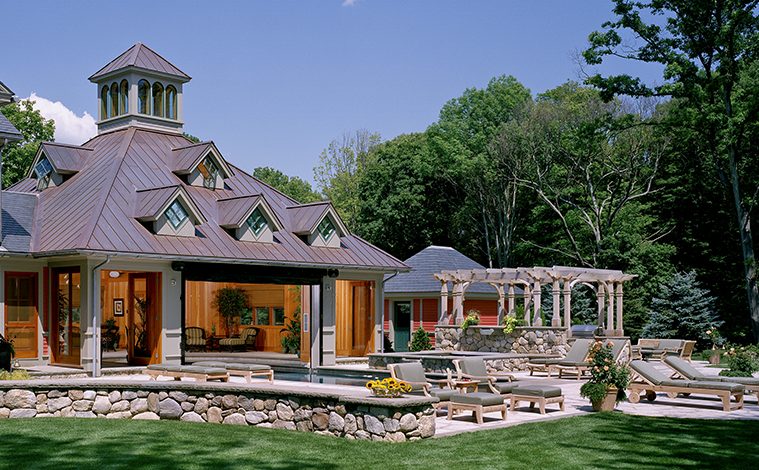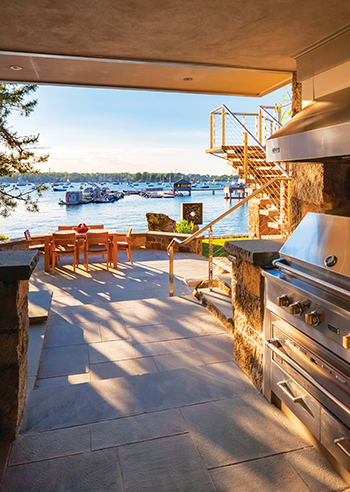The dinner bell was once the sound that summarily ended all outdoor activities, calling kids and adults inside to the kitchen or dining room. Now, that’s not necessarily the case—with the rising popularity of the outdoor kitchen, backyard enjoyment can extend through dinnertime, and beyond. These flexible spaces can be large or small, covered or uncovered, simple or fully equipped—as Thad Siemasko puts it, “With a little creativity, we can design an outdoor kitchen to fit almost any type of space.” Siemasko, principal architect at design firm Siemasko + Verbridge, helps clients temper their wish lists based on what’s available for their space and budget constraints.
“The first and possibly most important design feature that we consider is access to the outdoor kitchen from the primary indoor kitchen,” Siemasko explains. “Many people will have food storage and prep areas indoors, and do their cooking outdoors. It’s important to have a clear path. It’s not ideal to have to walk through a silk-carpeted dining room to get the food from one kitchen to another, so we try to avoid situations like that.”
|
While most outdoor kitchens will have a large central cooking element such as a gas or charcoal grill, many homeowners are moving far beyond the basics in their outdoor spaces. “I always say that if you’re going to make the investment in an outdoor kitchen, you shouldn’t compromise on the functional or design features that you need,” says Siemasko. Second to the grill or oven, Siemasko recommends a sink with a drain to streamline prep and cleaning— but microwaves, refrigerators, ice makers, pizza ovens, and even large outdoor fryers are also popular. As homeowners add elements to the kitchen, durability and weatherproofing become increasingly important. “Outdoor kitchens tend to be slightly less attractive in the off-season,” Siemasko explains. “We try to make them a bit more discreet by setting them off to the side; we also place them out of the direct paths of wind and water. We can also extend the season by putting a roof over the space or even locating it inside a screen porch.”
It’s all about balancing form, function, comfort, and convenience. “In an outdoor kitchen, you can cook at higher temperatures without issues of exhaust—it makes less of a mess and leaves more room for experimentation,” notes Siemasko. “But I also believe that you should get as much enjoyment from looking at the setup as you do from using it.”
Ken Dempsey, owner of Northshore Kitchens Plus, uses a similar big-picture approach when designing an outdoor kitchen. “It’s about the whole project, not just the grill or the seating. To make things the way you want, you have to consider the little and the big things.”
Dempsey considers the big things first: “We usually need about a 12-foot space, but that can be done in many different configurations.” Making sure that any electrical appliances are shielded from exposure to water is tantamount to the kitchen’s success. To that end, Dempsey will often locate kitchens underneath elevated porches or other waterproof structures. “Every situation is different,” he explains. “We can generally make it work with the space we’re given.”
If they have a pool, we can place the kitchen [nearby] so they can have easy access to food or drinks. Some clients will want extra space in their kitchens so they can prepare food while socializing with their guests.”
While the outdoor kitchen is a relatively new concept for the Northeast, trends and new technologies are developing all the time. “The current trend…is increasingly more sophisticated setups,” says Dempsey. “We often add tile floors, which are attractive and easy to clean, especially if we add a drain. Clients can also extend the season by adding a gas or a wood fireplace—it can take you from five or six months of use for the kitchen to nine or ten months of use. The outdoor kitchen can be a space you can live in.”
So where should prospective outdoor kitchen owners start? “I always suggest thinking flexibly, and trying on different options,” says Siemasko. “You can always test things out before settling in. Having a design professional to talk it through can really help clients figure out what they need to have and where they can afford to trim the budget.” Dempsey agrees: “Some setups will require more work than others—finding a gas line, ensuring that drainage is available, and potentially pouring a foundation can all affect the budget and available options for the outdoor kitchen.”


 Photo by Brian Vanden Brink
Photo by Brian Vanden Brink